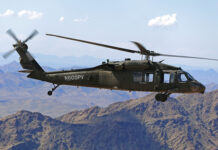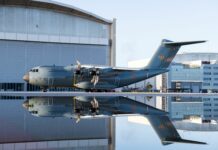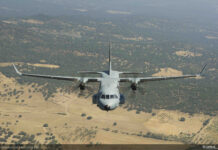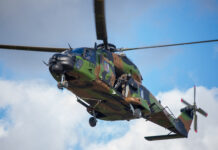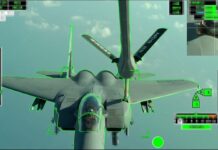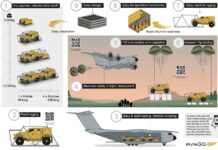With seven partner nations, the UK, France, Germany, Spain, Belgium, Luxembourg and Turkey involved, few collaborative defence projects have had a history as turbulent as that of the A400M.
With a crew of three (two pilots and a loadmaster alongside the option of a third person on the flight deck) who operate it with an advanced glass cockpit derived from A380 super jumbo (with the addition of a head-up display), the A400M has significant potential. With a top speed of Mach 0.72 at 40,000 feet and payload of 37 tonnes which it can carry 2000 nm, Airbus have marketed this aircraft as performing ‘delivery to the point of need’. By this, the company claims the A400M is able to deliver large loads to improvised and remote airstrips into potentially hostile environments, thanks to defensive aids, thus being able to act as both a tactical and strategic transporter for military payloads in addition to civilian cargo in Humanitarian and Disaster Relief (HADR) efforts. Various loadout options are available, from paratroopers with cargo/equipment pallets to Casualty Evacuation (CASEVAC) in addition to the ability to carry large Protected Mobility Vehicles (PMVs) and helicopters (including the CH-47 CHINOOK or multiple AH-64 APACHEs and various medium types). To make loading easier, the rear of the fuselage can be lowered into a ‘squatting’ position and a mechanical winch inside the cargo hold can be utilised to help load and off-load cargo. The aircraft is also equipped with two underwing air-to-air refuelling hoses to extend the range of fighter aircraft, while a hose and drum system can be fitted in the cargo hold the refuel larger aircraft. The A400M also has its own air-to-air refuelling probe mounted above the cockpit to receive fuel from other tanker aircraft.
The Origins
The A400M has its origins in the 1982 Future International Military Airlifter (FIMA) project which sought to replace the C130 HERCULES and C160 TRANSALL used by different European Air Forces at the end of the Cold War. This became the Future Large Airlifter (FLA) in 1991, involving British Aerospace, Aerospatiale, Deutsche Aerospace, Alenia and CASA as US company Lockheed had pulled out in 1989 to focus on developing what became the C130J SUPER HERCULES. The FLA programme soon evolved to be taken on by Airbus Military, when the latter was created in 1995, with the programme also being joined by Belgian and Turkish industry in 1998. However, the complexity of the programme, differing requirements and internal restructuring within the company led to significant delay. One such cause of this was disagreement on the powerplant for the aircraft, with some partners favouring an off-the-shelf engine from Pratt and Whitney Canada, whereas others preferred (the ultimately selected) solution developed by the EUROPROP consortium (which has the unusual feature of the two propellers on each wing counter rotating). Italy withdraw from the programme and Germany considered a Westernised Antonov 70 as an alternative, with the UK leasing four C17A GLOBEMASTER IIIs as an interim measure in 2001. These aircraft were later purchased outright and joined by a further four within the following decade. The A400M design proposal was delivered in July 1999 then accepted in July 2000, though the first prototype didn’t fly until December 2009, the year in which cost overruns put the aircraft €11Bn over budget. This led Airbus to suggest the aircraft could be cancelled, forcing the partner countries to provide a €1.5Bn loan and reduce the combined order to 170 aircraft (down from the original 212). The aircraft finally made its operational debut in December 2013 when it transported supplies to French forces in Mali under Operation SERVAL. However, more difficulty was to follow on 9 May 2015, when an aircraft destined for the Turkish Air Force crashed shortly after taking off from the final assembly plant in Seville, Spain. The incident, caused by a software failure, led to an overhaul in Airbus’s management structure and blunted the momentum of the programme.
Despite this, however, the aircraft has enjoyed a renaissance in Turkish service, with it reportedly being used in March 2017 to support President Erdoğan’s visit to Russia for a summit with President Putin. Difficulty has continued after this fatal incident, however, as the aircraft has suffered from flaws in its air-to-air refuelling capabilities, which all of the partners, except the UK due to contractual obligations with its leased A330 Multirole Tanker Transport (MRTT) fleet, intend to utilise. Tests found that the wash created by the propellers made it unsafe for the aircraft to refuel helicopters, a key capability for the French Air Force, in order to refuel its CARACAL Combat Search and Rescue (CSAR) helicopters. As a result of this and wider delays to the programme, France and Germany are to establish a joint C130J squadron at Evreux Air Base in France’s Normandy Region.

France will operate four aircraft, two each in the C-130J transport and KC-130J tanker configuration with Germany buying three of each type to prevent any transport or aerial refuelling capability gaps arising from A400M delays. Final certification for helicopter air-to-air refuelling is expected by 2021, with ‘dry’ contacts between the A400M and a helicopter carried out in September 2019.
Successful Operations
Despite the need for this C130J purchase, the A400M has enjoyed some success in French service during ongoing operations in sub-Saharan Africa. It was reported in September 2018 that French Foreign Legion paratroopers conducted a parachute jump in cooperation with mechanised forces in order to improve mobility over Jihadi fighters in the region. The assault involved 120 paratroopers with 80 deployed from two C-160 TRANSALL legacy transport aircraft and 40 from an A400M. The following September, a French Air Force A400M airdropped supplies to Kidal Air Base in the Sahara as part of Operation BARKHANE, with France as one of the leading partner nations in refining the A400M’s capabilities. In July 2019, a French A400M successfully deployed 58 paratroopers from one of its side doors and in May 2020, France’s procurement agency, the DGA, announced successful trials towards maximum paratrooper deployment of 116 simultaneously (58 from each side door), paving way for this capability to become available in 2021.
Humanitarian Aid
Another important role envisaged for the A400M is the Humanitarian Aid and Disaster Relief (HADR) mission, where it proved its value during the 2017 Hurricane season in the Caribbean. In response to this, the Royal Air Force deployed two A400Ms (alongside a C130J and multiple C17As) under Operation RUMAN to deliver key humanitarian equipment to the region. It was reported that the aircraft proved invaluable by being able to reach the Caribbean by flying over the Atlantic via the Azores compared to the C130J, which had to transit via the US and Canada. Once in theatre, the A400M also demonstrated its ability to carry oversized aid cargo, such as a mechanical digger, around the area. The French Air Force also deployed an A400M to transport cargo which included a PUMA tactical helicopter.

Airbus has also reported that the A400M’s only export customer to date, Malaysia, used their four examples to deploy HADR to Indonesia after an earthquake in October 2018 which affected the island of Palu. The manufacturer also said that the aircraft was the only one in theatre able to carry a 22-tonnes excavator and fuel truck needed in the area. This capability is becoming a key marketing point for Airbus when trying to sell the A400M overseas (in March 2019, A400Ms from the UK, Spain and Turkey delivered HADR to Mozambique following Cyclone Ida) to nations including Indonesia. With neighbouring Malaysia having already used the type to deliver large loads to remote areas (alongside providing air-to-air refuelling to its fast jets), Indonesia’s Ministry of Defence approved the purchase of five A400Ms in January 2017. This was followed in March by a Letter of Intent with Pelita Air Services, a consortium of Indonesian Aerospace firms, though little has been heard of the deal since.
Air-to-Air Refuelling
As the A400M continues to be utilised more for air-to-air refuelling (Germany deployed it for this function with combat aircraft over the Middle East in July 2019, despite reports in November 2019 it refused to accept two examples due to reliability issues), the only partner not deploying the aircraft for this function, the UK, is however using it in more specialist roles. The RAF has been using the A400M to support its operation against the so-called Islamic State in Iraq and Syria since 2015 and also deployed it to Exercise Mobility Guardian in 2017 to test the type’s ability to carry specialist loads, including the US Army’s STRYKER 8×8 wheeled vehicle.

These were followed in 2018 by 206 Squadron, RAF, charged with operational evaluation for transport types, testing the aircraft’s beach landing capabilities in West Wales. The aircraft has still attracted controversy, however, after reports surfaced in the UK press during July 2019, that only two of the RAF’s 20 A400Ms were available due to reliability issues. With a maximum range of 4800nm, the A400M has also been used by the RAF for one of its longest running operational commitments. Ever since the 1982 war, the UK Armed Forces have had a significant presence on the Falkland Islands of which the air element includes four EUROFIGHTER TYPHOON fast jets, a A330 Multi-Role Tanker Transport (MRTT) and since April 2018, an A400M. Having replaced the C130 HERCULES previously stationed at Mount Pleasant airfield, this aircraft provides British forces in the area with a tactical airlift capability. It can also be used for maritime reconnaissance in this theatre (despite lacking specialist equipment) in addition to Search and Rescue (SAR).
Indeed, for the latter, the aircraft played a part in the search for a Chilean Air Force C130 which went missing near Antarctica in December 2019. In addition to the RAF supplying specialist personnel, the Falkland Islands based A400M carried out ‘specialist reconnaissance flights’ to find the missing aircraft.
COVID 19 Missions
In addition to taking on more routine missions including the support of a Spanish Air Force deployment of EUROFIGHTER TYPHOONs to Latvia as part of NATO operations in March 2018, in recent months, the aircraft has been at the forefront of efforts across Europe to counter the worst effects of the COVID 19 pandemic. In Spain, it has been used to transport urgently needed Personnel Protective Equipment (PPE) around the country and images appeared of a German example transporting COVID patients from France to Germany for treatment. The aircraft has also been utilised by the UK to transport COVID positive patients from Scotland’s remote islands to the mainland for treatment while it had particular exposure in April 2020 when, at the height of the outbreak, the UK government ordered a shipment of PPE from Turkey and dispatched an A400M (with two more on standby) to Istanbul to collect it. Accounts differ as to the cause, but the consignment was delayed by several days, leading to pictures which circulated widely in the media of the aircraft sitting idle on the Istanbul runway while PPE shortages continued. Following this episode, in May 2020, the Turkish Air Force used its A400Ms to transport key COVID 19 aid, including ventilators, to the Somali capital Mogadishu.
Deliveries
Of the 174 number of aircraft on order, 90 have been delivered at time of writing, including the sole example ordered by Luxembourg, which first flew in April 2020 with delivery thought to be imminent, after which it will be operated as part of a joint fleet with the seven examples ordered by Belgium. A notable trait of the A400M programme, possibly due to its long delays, is the lack of exports. South Africa signed up to purchase eight aircraft in April 2005 but the order was cancelled in November 2009. During 2005, the Chilean Air Force planned to acquire the A400M to replace the C130 and the country’s government attempted to negotiate industrial involvement in the programme. However, this also fell through. Since, sales to states in the Middle East including to Algeria, Saudi Arabia, Egypt and the UAE have been suggested but have yet to materialise while in Oceania, the C17 was selected by Australia over the A400M to supply a large airlifter in the early noughties. More recently, in New Zealand’s competition to find a new airlifter to replace its ageing first generation C130s, the C130J SUPER HERCULES was selected over more modern types including the A400M.
Exports

Despite these setbacks, there are continued reports of opportunities Airbus is pursuing to export the type but another consequence of the delays is the fact that several partner nations have reduced their planned A400M purchases. The UK originally planned to purchase 25, a figure reduced to 22 (with 21 delivered to date). Germany’s original requirement was for 60, later reduced to 53, though 13 of these will not enter service. As a result, it has been reported these surplus aircraft could be sold to another country. Another option, proposed in February 2017, was these aircraft being purchased jointly by Switzerland and the Czech Republic in a joint pool to replace their ageing transport fleets, though little of this plan has been heard since. However, there have also been reports Germany will base its surplus aircraft at Lechberg Airbase near Augsberg and crew them on a multinational basis. This plan, if it comes to fruition, would not be without precedent as the NATO Strategic Airlift Capability operates a joint C17 fleet from Hungary and Germany is joining not only the combined C130J fleet with France, but also the Multinational Multirole Tanker Fleet with the Netherlands, Belgium and Norway, in order to increase European air-to-air refuelling capacity with a pooled A330 MRTT fleet. Spain also decided to defer 13 of its 27 planned airframes to later in this decade (with reports A330 MRTTs could be built instead) and there have been reports that the country is in negotiations South Korea to purchase at least some of these aircraft. It has been suggested that in exchange, Spain would purchase a number of KAI GOLDEN EAGLE Advanced Jet Trainers to replace its legacy F5E TIGERs used in this role. This comes after South Korea failed to purchase the C17 before its production ended in 2015. As a result of this competitor aircraft no longer being available (the final surplus example was purchased by India), analysts have proposed another possible market for the A400M. The US currently operates a large number of C130Js (and other specialist derivatives) C17s and C5M SUPER GALAXY’S but lacks a medium ‘strategical’ airlifter between the C130J and C17 that can reach unprepared airstrips with large payloads. IHS Janes’ proposed in 2018 that as these aircraft age, the A400M could serve as a replacement, with the C130J and C17 having maximum payloads of 21,772kg and 76,655 kg respectively, the A400M could fill this gap. However, any such acquisition (which could potentially extend to triple figures) would be subject to political considerations such as domestic manufacture and the US Air Force’s experience with Airbus’s MRTT proposal.
The Way Ahead
The A400M has had a long and troubled entry to service, at various times coming close to cancellation, missing several valuable opportunities along the way. Now that it has begun to pass key milestones in developing its full potential and started to be proven on different types of operations all over the world, attention has been drawn to it for more positive reasons. At time of writing in late May 2020, it was announced that the aircraft was also certified to fly at low level on autopilot. However, the prolonged road to this point has meant that many high-profile races to supply replacements for legacy airlifters to air forces around the world have been won by competitors, an issue compounded by customer nations scaling back commitments leaving surplus examples which can be sold without extending production. This situation is only going to get harder, as international defence budgets are likely to contract in the light of COVID 19 and more competitor airlifters (such as the C-390 MILLENIUM from Embraer and the Kawasaki C2) become available. On the positive side, however, its large size gives the A400M a degree of future proofing as military hardware payloads (such as aircraft and PMVs become larger) and volumes of HADR supplies become larger. Overall, though, it is too early to know the full nature of the way ahead for the A400M.
Jack Richardson



